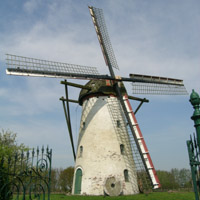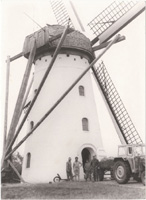The Meetjesland in the north of East-Flanders, Belgium
Ertvelde's Stone Mill site
Here in Ertvelde we have a site truly unique in Europe: a beautiful authentic stone mill together with a horse mill. What's more: both the wind mill and the horse mill are not merely in working order but in regular use. Mr. Johan Van Holle, a native of Assenede, uses the horse mill mostly for milling grain to feed his horses.
Of course when wind was king there were many windmill sites where they also had a horse mill for rainy, sorry I mean for windless days. But horse mills were much easier to destroy than tower mills.
 In 1798 Pieter Cornelis Genbrugge, the son of Lieven and his wife Anna Cornelia
Goethals, ordered the construction of a windmill, a horse mill and a house.
And Ertvelde's Stone Mill was built in 1799 probably by Fredericus Pisonier from
Sleidinge. He came from a well
known family of millwrights to which also belonged Augustinus, Petrus, Victor
and Edmond Pisonier. They didn't have to build it on a mountain because
they chose to put it on Ertvelde's highest point.
In 1798 Pieter Cornelis Genbrugge, the son of Lieven and his wife Anna Cornelia
Goethals, ordered the construction of a windmill, a horse mill and a house.
And Ertvelde's Stone Mill was built in 1799 probably by Fredericus Pisonier from
Sleidinge. He came from a well
known family of millwrights to which also belonged Augustinus, Petrus, Victor
and Edmond Pisonier. They didn't have to build it on a mountain because
they chose to put it on Ertvelde's highest point.
Even though we were in the destructive period of the French Revolution it looks like Mr. Genbrugge prospered. And what's more: his wife gives him 5 sons: Charles-Louis, Ferdinand, Jan-Bernard, Theodoor en Jan-Baptiste.
Even so, in 1832 he wants to borrow some money. And Miss Livine Wille, a beguine in St.-Elisabeth-ter-Engelen ("engel" = angel) in Ghent lends him 600 guilders. The deed is signed in "Den Grooten Spiegel" (The Big Mirror), an inn in the St. Jacobsnieuwstraat in Ghent. Our miller has to pay an annual interest of 30 guilders and his wind mill, horse mill, house, land and vegetable garden serve as collateral.
On 24 May 1842 Genbrugge's wife dies and 10 years later, on 9 September 1852, he too returns to his Maker. A few months before his death his children had set up a "sociëteit", a company to manage his estate in joint ownership. And the five brothers together continue as millers and farmers.
In March 1853 Jan-Baptiste marries and sets up shop elswhere. The others pay him 2114 franks for his part of their inheritance. In 1862 the mill is in need of major repairs, for instance the windshaft has to be replaced. That is the shaft with at one end the sails and at the other the large break wheel. The work is carried out by Charles Rombout from Wachtebeke, another well known son of a family of millwrights. He signs with "CR 1862" in the shaft.
 For some reason, perhaps because of the enormous costs involved, the 4 remaining
brothers decide to split up the undistributed estate. Jan-Bernard and
Ferdinand remain the millers. They receive the windmill, the horse mill,
the house, the stables, the oven, the orchard, the vegetable garden and some land,
in all 1.91 hectare (4.7 acres). Appearer Theodoor had already received 2,100
franks when he got married and now he receives an extra 650 franks in cash and also
the untrashed grain, i.e. wheat, rye and oats. The deed is signed in the
presence of Mr. Vermeersch, Notary public of
Ertvelde. Appearer Ferdinand declares
being unable to write or sign his name.
For some reason, perhaps because of the enormous costs involved, the 4 remaining
brothers decide to split up the undistributed estate. Jan-Bernard and
Ferdinand remain the millers. They receive the windmill, the horse mill,
the house, the stables, the oven, the orchard, the vegetable garden and some land,
in all 1.91 hectare (4.7 acres). Appearer Theodoor had already received 2,100
franks when he got married and now he receives an extra 650 franks in cash and also
the untrashed grain, i.e. wheat, rye and oats. The deed is signed in the
presence of Mr. Vermeersch, Notary public of
Ertvelde. Appearer Ferdinand declares
being unable to write or sign his name.
A few years later Ferdinand dies and in 1871 Jan-Bernard lets the mill, half of the house, the barn, the stables and the rest of the farm to Eugenius Neyt from Assenede for all of 520 franks per year. (Pardon me for this here parenthesis: bankers issued more gold certificates than they had gold bars in their vaults. In order to stop this fraud the government took over. And what was the result ? From the frying pan into the fire: 520 franks; that is now 13 euros. There is no pub in the land where you could get 10 pints of real Belgian beer for 13 euros. They have a respectable word for this theft: inflation. If there ever was an even greater fraud than this then surely politicians are at cause there as well.) He, Eugene, was a descendent of the famous millers family from Wippelgem. The agreement stipulates the tenant is allowed to make improvements on the mill but for the mill stones he must get the approval of Karel Rombout from Wachtebeke.
On 13 January 1873 Jan-Bernard Genbrugge dies and his heirs including his widow Victoria van de Rostijne, decide to sell the entire estate. This auction takes place on 2 April in the pub of Charles-Louis Genbrugge in Ertvelde. The sale was done with "keersbranding": a candle (keers, kaars) is lit and the last bidder before it dies wins the sale. And here Eugeen De Rijcke, a farmer from Assenede is awarded the sale for 13,360 (thirteen thousand three hundred and sixty) franks. (Talk about watering down the value of money: in 2005 you can't even get a decent second hand motor bike for 15,000 franks; in many restaurants dinner for two will set you back 4,000 franks or more. No, I'm not the only one who still converts euros to defunct franks—thanks for asking.)
Mr. De Rijcke was in fact only a straw man for the tenant who had to pay up within 14 days and in hard cash; coins of less than 5 franks were not acceptable.
 During his career Eugene Neyt, the miller now also the owner, makes a lot of
improvements. So much in those days was do-it-yourself. In 1906 a new brake
was installed. The millstones were dressed several times which indicates
that a lot of milling was done. From 1914 on the mill could also be operated
electrically when there was not enough wind. And Eugenius worked his mill
till 1925 when he left it in the hands of his children Helena, Joannes, Marie
and Cyriel.
During his career Eugene Neyt, the miller now also the owner, makes a lot of
improvements. So much in those days was do-it-yourself. In 1906 a new brake
was installed. The millstones were dressed several times which indicates
that a lot of milling was done. From 1914 on the mill could also be operated
electrically when there was not enough wind. And Eugenius worked his mill
till 1925 when he left it in the hands of his children Helena, Joannes, Marie
and Cyriel.
Cyriel especially had learned a lot in the Netherlands during WW I (when the Dutch remained neutral and stayed out of the war). In the 1920's second hand clinch-nailed rods were installed. The mill was then considered as one of the best running mills of our Meetjesland. In 1953 Cyriel inherits the whole estate. And he goes on running his mill until 1965. From then on the mill runs only occasionally and a period of decline sets in. After the death of "Cyrielke" Neyt in 1978 his heirs eventually decide to sell.
And at last in 1980 in the nick of time Mr. Johan Van Holle from Assenede buys the windmill, what's left of the horse mill, the house and the barn. Just in time because they were all set and ready to sell the whole site in separate lots for villas. If these sales had gone through the horse mill would have been one of the first to disappear and of course no one knows what would have become of the stone mill. So congratulations to Mr Van Holle who immediately went to work repairing or at least provisionally securing and protecting from further or irreparable damage, with roofing, wood panels and window panes to keep out the rain and get the mills running again in hope the big overhaul comes soon.
 And the big overhaul had to wait until the very
important and very polite civil servants of the Ministries of This, That and the
Other can recount their bloated wages, read the papers, have a short or not so
short siesta and then get together perhaps, to take the decision without knowing
anything much about the "case" and then eventually order someone else
to draft a new law to order the restoration and until the money can be
"found" for this urgent and thorough restoration of the whole site.
(If you think money should be easy to find for those who print it themselves, perhaps
you don't know all there is to know about how ministries operate.) Because
since 1970 the Stone Mill is a listed and protected monument. And that means
Minister Know It All or rather one of his underlings must decide everything even if
they don't know anything about windmills and care even less. And in 1986 that
protection was extended to the whole site.
And the big overhaul had to wait until the very
important and very polite civil servants of the Ministries of This, That and the
Other can recount their bloated wages, read the papers, have a short or not so
short siesta and then get together perhaps, to take the decision without knowing
anything much about the "case" and then eventually order someone else
to draft a new law to order the restoration and until the money can be
"found" for this urgent and thorough restoration of the whole site.
(If you think money should be easy to find for those who print it themselves, perhaps
you don't know all there is to know about how ministries operate.) Because
since 1970 the Stone Mill is a listed and protected monument. And that means
Minister Know It All or rather one of his underlings must decide everything even if
they don't know anything about windmills and care even less. And in 1986 that
protection was extended to the whole site.
The mill was fully restored in 1985: the body of the mill was heightened by about half a meter and it was equiped with the improved jib-sails of Mr. Fauel's invention. It has two pairs of millstones and an oat roller. It is fully operational. And when the brake is off the slightest breeze sets it off. Mr. Van Holle can be really proud of his work. The horse mill is once again in regular use milling grain, also to feed the animals.
There is an inn next door where one can sample local produce made i.a. with grain milled by the Stone Mill.
Our source for most of the above: "Ons Meetjesland" (Our Meetjesland),
15th year, number 2, 1982, an article by Mr. Johan Van Holle. For those of
you who read Dutch here
is Mr. Van Holle's original text.
Comments about politicians, ministries and debasing currencies are ours and we take
full responsibility for them.
All about the windmills of our Meetjesland
Our list of the windmills of our Meetjesland
About Ertvelde

More pictures
Our Meetjesland
— Table of Contents
— Find something in this Meetjesland website

MijnPlatteLand.com
Most recent update : 22-04-2021
Copyright Notice (c) 2024
